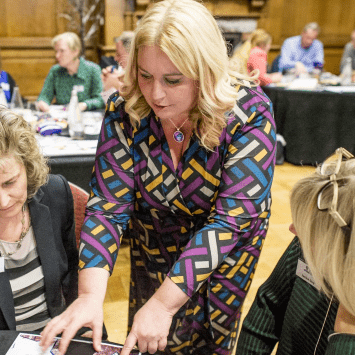Posted in Blog, Innovation, Innovation Culture, Strategy by Jo North
Cross-Sector Innovation for Breakthroughs and Growth
Breakthroughs happen when teams from different sectors combine deep expertise with unfamiliar insight. That mix challenges assumptions and makes space for new outcomes. Cross-sector innovation has become a serious tool for driving progress—less about coordination, more about producing something that wouldn’t happen otherwise.
This kind of innovation works best when it challenges the default. When a health system borrows risk modelling techniques from the insurance industry, or a logistics firm builds a product with academic researchers, something shifts. Not because it’s a fresh idea, but because it’s the right kind of pressure: unfamiliar enough to unsettle, useful enough to act on.
Why Cross-Sector Innovation Works
Advanced innovation is rarely blocked by lack of ideas. It’s slowed by overfamiliarity, entrenched framing, and slow feedback loops. Cross-sector work cuts across that. Different sectors hold different assumptions. When these rub together, you get better questions. High-quality cross-sector work sharpens the questions. It pushes thinking beyond the familiar and sets direction more deliberately.
In our work at The Big Bang Partnership, we’ve seen this in play across infrastructure, healthcare, energy, and research-intensive universities. We’ve supported strategic partnerships where priorities didn’t align neatly—but the shared challenge was real. That’s the key. Not alignment for its own sake, but shared need, approached from different angles.
Innovation ecosystems that support this kind of work start by building shared reference points through doing—not just talking. Moving quickly at the beginning helps test whether collaboration has substance before committing to structure.
When It Works, What Happens
Cross-sector projects can bring together the contextual knowledge of local councils with the technical expertise of health tech teams. This kind of combination offers practical ways to rethink how decisions are made and resources allocated.
Cross-sector collaborations that involve universities, environmental organisations, and commercial partners can reveal new approaches to long-term funding. Each brings a different perspective on value, risk, and success. The real work happens in how those differences are handled—not smoothed over, but used to shape something more robust.
Cross-sector work handles complexity head-on. It gives each partner the space to raise what matters, test assumptions early, and keep moving.
Structure Beats Sentiment in Cross-Sector Innovation
Cross-sector innovation fails when it leans too heavily on goodwill and not enough on structure. Effective collaboration needs the right scaffolding: clear scope, time-bound experiments, and an understanding of what each party puts in and gets out. Cultural sensitivity matters. So does IP clarity. So does shared access to useful data—primary, secondary, and observed.
Co-creation works when it’s anchored in structure—clear framing, feedback, and iteration that leads somewhere useful. Many of the best cross-industry partnerships we’ve seen started small and informal—but they had structure from day one. Not polish. Just clarity.
Value Flows in Both Directions
There’s growing recognition that cross-sector innovation is commercially smart. It expands your field of view, stress-tests assumptions faster, and often points to routes for product development or service improvement that wouldn’t be obvious from inside the system.
We’ve seen organisations in the industrial sector rethink procurement after working with social enterprises. We’ve seen public health teams draw on community engagement methods from the video game industry. None of this is theoretical. The impact is measurable: faster development, more inclusive reach, better adoption.
For teams working on population health, climate change, or service innovation—particularly where funding is shared or outcomes are multi-layered.
Cross-Sector Innovation: Additional Observations
Common Goals
Cross-sector innovation ecosystem collaborations benefit when diverse partners are aligned on common goals but also recognise where their differences bring value. This is especially important in initiatives that touch on social services sector alignment or health equity, where community voice needs to be part of the process—not an afterthought.
Collaboration Capabilities
Collaborative efforts with government agencies, civil society, and non-profit organizations require more than goodwill. They call for collaboration capabilities: effective communication, knowledge exchange, and skill enhancements that can stand up to real-world complexity. In recent years, more projects have embedded these elements early, using best practices from application development, data analytics, and strategic thinking.
Data Sharing
Data also plays a bigger role than it once did. Primary data from healthcare settings, combined with secondary data from demographic sources or environmental reporting, improves decision-making at pace. We’ve seen this shape ecosystem management strategies and drive innovation in fields where conventional models have hit limits.
Non-Competing Objectives
For private sector organisations, cross-industry innovation opens up access to new markets and customer bases. For non-profits, it helps scale social innovation without losing depth. These are not competing goals. With the right structure and sustained focus, they reinforce each other.
Learning and Growth
We’ve also seen the benefit of a series of posts or project reports to capture learning, share progress, and maintain momentum. Where initiatives fail, it’s often due to a lack of open dialogue or clarity around the second step after a promising pilot. A successful collaboration doesn’t just launch—it adapts, stretches, and pushes forward.
Build What You Need
If you’re serious about building cross-sector capability:
- Start with a specific issue, not a vague goal.
- Choose partners based on relevance, not availability.
- Start small. Use short cycles to test collaboration, not long steering groups.
- Invest in facilitation that holds the work, not just the agenda.
Cross-sector innovation is a method that delivers practical outcomes—new business models, sharper decisions, and real results. It supports continuous learning and the kind of risk management that adapts fast.
Cross-Sector Innovation: Final Thoughts
Collaborate with precision. Choose people and organizations who bring different insight and care about the outcome as much as you do.
The Big Bang Partnership designs and facilitates advanced cross-sector programmes and strategic partnerships. We work with teams facing complex, high-stakes challenges who need sharp thinking, clear outcomes, and progress that holds under pressure.
Contact us if you’d like to explore cross-sector programmes and strategic partnerships for your organization.


